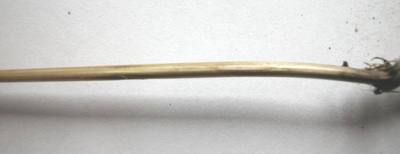Diseases
Cercosporella herpotrichoides Fron. - eyespot.
Systematic position.
Fungus Cercosporella (Pseudocercosporella) herpotrichoides belongs to imperfect fungi - class Deuteromycetes, order Hyphomycetales.Biological group.
Hemybiotrophic parasites.Morphology and biology.
The most obvious symptom of this disease are the appearance of distinct "eye-spots". The elliptical lesions are bordered by dark brown rings, have straw-colored centers, and frequently develop on the leaf sheath at soil level. When disease development is severe, a stem or culm may break near the ground or through the lesion where the stem is weakened. No symptoms appear on roots. Primary infection is caused by conidia or mycelia formed on crop debris on or near the soil surface. Conidia are spread by splashing rain to a distance of 1 to 2 m. The new inoculum appears on developing coleoptile or on basal areas of young culms in 4 to 12 weeks. The fungus is confined to the basal parts of a plant, rarely developing higher than 15-20 cm above soil level. Conidiophores of pathogen are long, cylindrical, uncolored, slightly thickened towards apex, coming out from stoma in tufts. Conidia are solitary or forming small groups, uncolored, having 5-7 septae, tapering, 30-70 x 1-3 microns. Unicellular or 2-3-septated sporidia forms not infrequently, going out from basal or middle parts of conidia. Microsclerotial bodies abundant, black, 100-500 microns in diameter. The fungus survives on the straw of cereals.Distribution.
Wheat, triticale, rye, oats, and other related grasses can be affected by the disease, but wheat is the most susceptible. This disease is found in the North Caucasus, in the European and North-Western regions of Russia, in Baltic countries and Ukraine.Ecology.
Eyespot development is favored by cool damp weather and by high soil humidity. This fungus requires high relative humidity and 2-15.C temperature (7 .C is optimum) for sporulation. The pathogen development on sheaths stops when the temperature rises above 20-25.C. Mild winters and cool springs prolong infection period.Economic significance.
Eyespot may kill individual tillers or even whole plants. Yield losses often result from reduced kernel size and number. The harmfulness of disease depends on the time of plant inoculation and on the rate of lesion. The mass of 1000 seeds may decrease by 16.5% and the number of seeds by 26.5%. As a result, the yield losses amount to 20%. Control measures include rotation with susceptible cereals grown in one or more years, deep plowing of infested soil; using tolerant cultivars (resistant ones are not available) and fungicides in risk areas.Reference citations:
Dzhumabaev P. 1966. Eyespot of cereals in the USSR. PhD thesis. Leningrad. 1-24 p. (In Russian)Zhalieva L.D. 1987. Eyespot of winter wheat and the disease control in Krasnodar Region. PhD thesis. Krasnodar. 1-18 p. (In Russian)
© Gagkaeva T.Yu.


